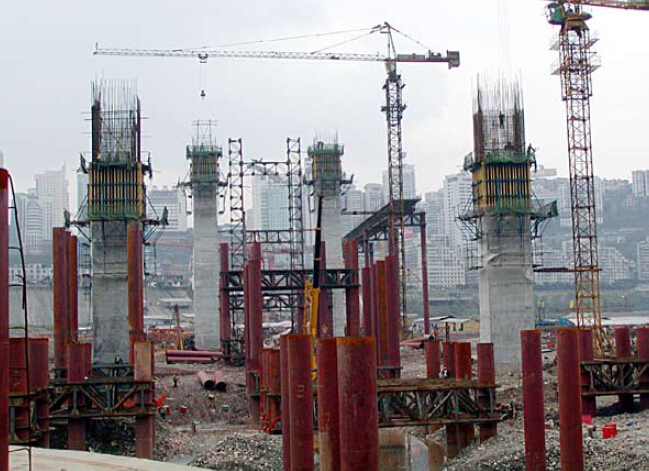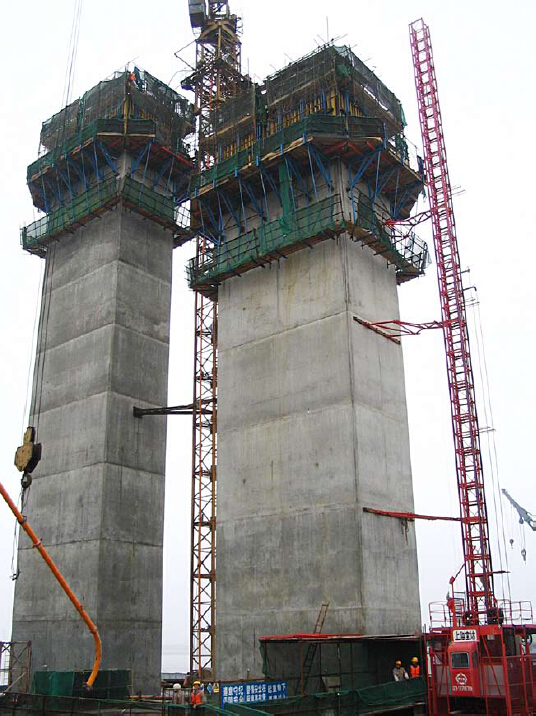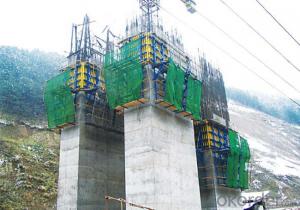Climbing Bracket CB-240 for formwork and scaffolding system
- Loading Port:
- Tianjin
- Payment Terms:
- TT OR LC
- Min Order Qty:
- 50 m²
- Supply Capability:
- 1000 m²/month
OKorder Service Pledge
OKorder Financial Service
You Might Also Like
Climbing Bracket CB240 & CB210
They are framework brackets for supporting large-area wall formwork.
Typical applications for the CB240&CB210 are pier and column/shear wall/core walll/ in the
building.
CB210 has smaller size than CB240, it will be cost effective in some condition.
Characteristics:
◆ High bearing capacity
The high loading capacity of the brackets allow very large scaffold units. This saves the number
anchor points required as well as reducing climbing times.
◆ Simple moving procedure by crane
Through the strong connection of formwork together with the climbing scaffold, both can be moved
as a single climbing unit by crane. Thus valuable time-savings can be achieved.
◆ Fast striking process without a crane
With the retrusive set, large formwork elements can also be retracted quickly and a minimum of
effort.
◆ Safe with work platform
The platforms have assembled firmly with bracket and will be climbing together, without scaffolding
but can work safely in spite of your high location.


- Q:How does steel formwork contribute to the overall construction process?
- Steel formwork plays a crucial role in the overall construction process by providing a strong and durable framework for concrete structures. It offers numerous advantages over traditional wooden formwork, making it a preferred choice for many construction projects. Firstly, steel formwork is highly durable and can withstand multiple uses, resulting in cost savings as it does not require frequent replacement. This longevity also contributes to sustainability in construction, reducing waste and environmental impact. Secondly, steel formwork offers excellent strength and stability, ensuring the integrity of the concrete structure. It can withstand high pressures and vibrations during the pouring and curing process, resulting in a smooth and even finish. The precision and accuracy provided by steel formwork also help in achieving the desired dimensions and shape of the concrete structure. Moreover, steel formwork is highly adaptable and customizable, allowing for flexibility in design and construction. It can be easily adjusted or modified to accommodate changes in the architectural or engineering plans, saving time and effort. This flexibility also enables the construction of complex and intricate structures, such as curved or sloped walls, which would be challenging to achieve with traditional formwork methods. Another significant advantage of steel formwork is its reusability. Unlike wooden formwork, which is typically discarded after a few uses, steel formwork can be dismantled, cleaned, and reused on multiple projects. This not only reduces construction costs but also minimizes waste generation and promotes sustainable construction practices. In addition to its durability and adaptability, steel formwork offers improved construction speed and efficiency. Its lightweight nature allows for easy handling and assembly, reducing labor and construction time. The smooth surface of steel formwork also aids in quick and efficient concrete pouring and finishing. Overall, steel formwork contributes to the overall construction process by providing a sturdy, versatile, and reusable framework for concrete structures. Its durability, strength, adaptability, and efficiency make it an indispensable tool in modern construction, ensuring the successful and timely completion of projects while maintaining high-quality standards.
- Q:How does steel formwork affect the overall stability of the structure?
- The construction industry heavily relies on steel formwork, which plays a vital role in determining the stability of structures. When compared to materials like wood or plastic, steel formwork offers superior strength, durability, and stability. Steel formwork greatly affects a structure's stability by providing firm support during the pouring and setting of concrete. Its strong and sturdy nature ensures that the formwork stays in place, preventing any deformation or collapse. This stability is particularly crucial during the curing phase when the concrete gains strength and hardens. Acting as a temporary structure, steel formwork holds the concrete in place until it becomes self-supporting. Furthermore, steel formwork allows for precise alignment of the concrete, resulting in a well-defined and stable structure. The accurate dimensions and tight joints of steel formwork ensure controlled pouring, eliminating any potential irregularities or weaknesses. This level of accuracy and stability is essential in critical areas such as load-bearing walls, beams, and columns. In addition, steel formwork provides resistance against external forces and environmental factors that can impact a structure's stability. Its inherent strength makes it highly resistant to bending, twisting, and warping, ensuring the formwork remains intact under the weight of the concrete and any imposed loads. Steel formwork also offers excellent resistance to moisture, temperature variations, and chemical exposure, which can compromise the stability of other formwork materials. Moreover, the reusable nature of steel formwork makes it a cost-effective and sustainable choice. Its durability allows for multiple uses, reducing the need for frequent replacements and minimizing construction waste. This aspect contributes to the overall stability of the structure as it ensures consistency in formwork quality throughout the project, avoiding any potential variations in stability that might arise from using different materials or techniques. In conclusion, steel formwork has a significant impact on the overall stability of a structure. Its strength, durability, and rigidity provide the necessary support and alignment for the concrete, ensuring a stable and well-defined structure. The resistance to external forces and ability to withstand environmental factors further enhance the stability of the formwork system. Ultimately, steel formwork is indispensable in the construction industry, contributing to the overall safety and longevity of structures.
- Q:How does steel formwork affect the overall thermal insulation of a building?
- Steel formwork has no direct impact on the overall thermal insulation of a building. Its purpose is to provide structural support while the concrete is poured and shaped. It is a temporary structure that is taken down once the concrete has hardened. The thermal insulation of a building is primarily determined by the materials used in the walls, roof, and floors, as well as the design and installation of insulation systems. These materials and systems are separate from the steel formwork used during construction. However, it is important to note that the use of steel formwork may indirectly affect the thermal insulation of a building. The construction process itself, including the use of formwork, can influence the quality of the insulation installation. If not managed properly, the installation of insulation materials during or after the removal of steel formwork may be compromised, resulting in gaps, voids, or inadequate installation that can impact thermal insulation. Therefore, it is crucial to ensure that proper construction practices are followed, and insulation materials are correctly installed after the removal of steel formwork. This will help maintain the desired thermal insulation performance of the building.
- Q:Can steel formwork be used for elevated water tanks?
- Yes, steel formwork can be used for elevated water tanks. Steel formwork is a versatile and durable solution for constructing elevated water tanks. It provides the necessary strength and stability required to support the weight of the tank and the water it holds. Moreover, steel formwork enables the construction of complex shapes and designs, allowing for customized tank designs to be created. Additionally, steel formwork offers excellent resistance to weather conditions and corrosion, making it suitable for long-term use in outdoor environments. Overall, steel formwork is a reliable option for building elevated water tanks, providing structural integrity and ensuring the safety and functionality of the water storage system.
- Q:What are the considerations when designing steel formwork for retaining structures?
- When designing steel formwork for retaining structures, there are several important considerations that need to be taken into account. These considerations include: 1. Load capacity: The formwork needs to be designed to withstand the weight of the concrete and any additional loads that may be imposed on it, such as soil pressure or hydrostatic pressure. The formwork must have sufficient strength and stability to support these loads without any deformation or failure. 2. Durability: Steel formwork should be designed to have a long service life and be capable of withstanding the harsh conditions that can be encountered during construction, such as exposure to moisture, chemicals, and temperature variations. The material used for the formwork should have corrosion-resistant properties to ensure its durability over time. 3. Ease of installation and removal: The design of the formwork should be such that it allows for easy and efficient installation and removal. This can include features such as modular panels or adjustable components that can be easily assembled and disassembled. The formwork should also be designed to allow for easy access during the pouring and curing of the concrete. 4. Flexibility: The design of the formwork should allow for flexibility in terms of accommodating different shapes and sizes of retaining structures. This can include adjustable components or the use of formwork systems that can be adapted to various geometries. This flexibility is important as it allows for the formwork to be reused for different projects, reducing costs and improving efficiency. 5. Safety: Safety is a critical consideration when designing steel formwork for retaining structures. The formwork should be designed to provide a safe working environment for construction workers, with features such as anti-slip surfaces, guardrails, and proper anchoring systems. Additionally, the formwork design should consider factors such as stability and load distribution to minimize the risk of accidents or collapse during construction. 6. Cost-effectiveness: The design of the formwork should aim to achieve cost-effectiveness by optimizing material usage, minimizing waste, and reducing labor requirements. This can be achieved through efficient design, such as using standardized components or modular systems that can be easily reused. The formwork design should also consider factors such as ease of maintenance and repair to minimize long-term costs. Overall, when designing steel formwork for retaining structures, it is important to consider factors such as load capacity, durability, ease of installation, flexibility, safety, and cost-effectiveness. By carefully considering these factors, a well-designed formwork system can be created that ensures the successful construction of retaining structures.
- Q:Are there any safety considerations when using steel formwork?
- Yes, there are several safety considerations when using steel formwork. Firstly, it is important to ensure that the formwork is properly erected and secured to prevent any potential collapse or accidents. Regular inspections should be conducted to check for any signs of damage or wear that could compromise the structural integrity. Adequate training and supervision of workers is crucial to ensure safe handling and installation of the formwork. Additionally, appropriate personal protective equipment (PPE) such as helmets, gloves, and safety harnesses should be provided and worn by workers at all times.
- Q:Can steel formwork be used in underground structures?
- Yes, steel formwork can be used in underground structures. Steel formwork is a versatile and durable construction material that can withstand the challenging conditions of underground structures. It offers excellent strength and stability, making it suitable for constructing walls, columns, and slabs in underground spaces. One of the key advantages of steel formwork is its ability to resist the pressure exerted by the surrounding soil and water. Underground structures often face high hydrostatic pressure, and steel formwork can easily withstand this pressure without deforming or collapsing. This ensures the safety and stability of the structure. Additionally, steel formwork is reusable, which makes it a cost-effective choice for underground construction projects. Its robustness allows it to withstand multiple uses, reducing the need for frequent replacements and lowering overall construction costs. Moreover, steel formwork offers flexibility in design and can be easily customized to meet specific project requirements. It can be fabricated into various shapes and sizes, allowing for the creation of complex geometries in underground structures. However, it is important to note that steel formwork requires proper surface treatment to protect it from corrosion in the underground environment. Special coatings or galvanization can be applied to prevent rusting and prolong the lifespan of the formwork. Overall, steel formwork is a suitable choice for underground structures due to its strength, durability, reusability, and flexibility in design. It can effectively withstand the challenges posed by the underground environment and ensure the long-term stability and safety of the structure.
- Q:What are the different types of formwork accessories used with steel formwork?
- There are several types of formwork accessories used with steel formwork, including form ties, formwork clamps, spreader bars, formwork brackets, formwork support systems, and scaffold brackets. These accessories play essential roles in ensuring the stability, alignment, and overall efficiency of the steel formwork during the construction process.
- Q:What are the common safety guidelines when working with steel formwork in hazardous areas?
- When working with steel formwork in hazardous areas, it is important to follow some common safety guidelines. These include wearing appropriate personal protective equipment (PPE) such as safety goggles, gloves, and steel-toed boots to protect against potential hazards. Additionally, workers should ensure that the steel formwork is properly installed and secured to prevent any accidents or collapses. It is also essential to be aware of the weight and load capacity of the formwork to avoid overloading and potential structural failures. Regular inspections and maintenance of the formwork are necessary to identify any defects or weaknesses that could compromise safety. Lastly, workers should be trained on emergency procedures and know the location of emergency exits and evacuation routes in case of any unforeseen incidents.
- Q:What are the different types of formwork connectors used in steel formwork?
- There are several different types of formwork connectors used in steel formwork, including wedge clamps, wedge bolts, pin and wedge systems, and snap ties. These connectors are essential for securely joining formwork panels together and ensuring the stability and strength of the formwork structure.
1. Manufacturer Overview |
|
|---|---|
| Location | |
| Year Established | |
| Annual Output Value | |
| Main Markets | |
| Company Certifications | |
2. Manufacturer Certificates |
|
|---|---|
| a) Certification Name | |
| Range | |
| Reference | |
| Validity Period | |
3. Manufacturer Capability |
|
|---|---|
| a)Trade Capacity | |
| Nearest Port | |
| Export Percentage | |
| No.of Employees in Trade Department | |
| Language Spoken: | |
| b)Factory Information | |
| Factory Size: | |
| No. of Production Lines | |
| Contract Manufacturing | |
| Product Price Range | |
Send your message to us
Climbing Bracket CB-240 for formwork and scaffolding system
- Loading Port:
- Tianjin
- Payment Terms:
- TT OR LC
- Min Order Qty:
- 50 m²
- Supply Capability:
- 1000 m²/month
OKorder Service Pledge
OKorder Financial Service
Similar products
New products
Hot products

























